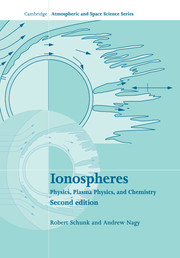Book contents
- Frontmatter
- Contents
- Chapter 1 Introduction
- Chapter 2 Space environment
- Chapter 3 Transport equations
- Chapter 4 Collisions
- Chapter 5 Simplified transport equations
- Chapter 6 Wave phenomena
- Chapter 7 Magnetohydrodynamic formulation
- Chapter 8 Chemical processes
- Chapter 9 Ionization and energy exchange processes
- Chapter 10 Neutral atmospheres
- Chapter 11 The terrestrial ionosphere at middle and low latitudes
- Chapter 12 The terrestrial ionosphere at high latitudes
- Chapter 13 Planetary ionospheres
- Chapter 14 Ionospheric measurement techniques
- Appendix A Physical constants and conversions
- Appendix B Vector relations and operators
- Appendix C Integrals and transformations
- Appendix D Functions and series expansions
- Appendix E Systems of units
- Appendix F Maxwell transfer equations
- Appendix G Collision models
- Appendix H Maxwell velocity distribution
- Appendix I Semilinear expressions for transport coefficients
- Appendix J Solar fluxes and relevant cross sections
- Appendix K Atmospheric models
- Appendix L Scalars, vectors, dyadics, and tensors
- Appendix M Radio wave spectrum
- Appendix N Simple derivation of continuity equation
- Appendix O Numerical solution for F region ionization
- Appendix P Monte Carlo methods
- Index
Chapter 13 - Planetary ionospheres
Published online by Cambridge University Press: 22 January 2010
- Frontmatter
- Contents
- Chapter 1 Introduction
- Chapter 2 Space environment
- Chapter 3 Transport equations
- Chapter 4 Collisions
- Chapter 5 Simplified transport equations
- Chapter 6 Wave phenomena
- Chapter 7 Magnetohydrodynamic formulation
- Chapter 8 Chemical processes
- Chapter 9 Ionization and energy exchange processes
- Chapter 10 Neutral atmospheres
- Chapter 11 The terrestrial ionosphere at middle and low latitudes
- Chapter 12 The terrestrial ionosphere at high latitudes
- Chapter 13 Planetary ionospheres
- Chapter 14 Ionospheric measurement techniques
- Appendix A Physical constants and conversions
- Appendix B Vector relations and operators
- Appendix C Integrals and transformations
- Appendix D Functions and series expansions
- Appendix E Systems of units
- Appendix F Maxwell transfer equations
- Appendix G Collision models
- Appendix H Maxwell velocity distribution
- Appendix I Semilinear expressions for transport coefficients
- Appendix J Solar fluxes and relevant cross sections
- Appendix K Atmospheric models
- Appendix L Scalars, vectors, dyadics, and tensors
- Appendix M Radio wave spectrum
- Appendix N Simple derivation of continuity equation
- Appendix O Numerical solution for F region ionization
- Appendix P Monte Carlo methods
- Index
Summary
This chapter summarizes our current understanding of the various ionospheres in the solar system. The order of presentation of the planetary ionospheres follows their position with respect to the Sun, that is, it starts with Mercury and ends with Pluto. The amount of information currently available varies widely, from a reasonably good description for Venus to just a basic guess for Pluto. In the last section of this chapter, the ionospheres of the various moons and that of Comet Halley are described. Here again the existing data are limited, with the exception of Titan, which is currently undergoing extensive exploration by the Cassini Orbiter.
Mercury
Mercury does not have a conventional gravitationally bound atmosphere, as indicated in Section 2.4. The plasma population caused by photo and impact ionization of the neutral constituents, which is present in the neutral exosphere, is an ion exosphere, not a true ionosphere. No quantitative calculations of the plasma densities have been carried out to date. The global Na+ production rate was estimated to be a few times 1023 ions s−1, but no other studies have been published and there are no observations concerning the thermal plasma densities. The Messenger spacecraft is currently on its way and will be placed in orbit around Mercury in 2011. Our understanding of Mercury's environment will increase significantly with data from a successful Messenger mission.
Venus
Of all the nonterrestrial thermospheres and ionospheres in the solar system, those of Venus have been the most studied and best understood, mainly because of the Pioneer Venus Orbiter (PVO) spacecraft, which made measurements over the 14-year period from 1978 to 1992.
- Type
- Chapter
- Information
- IonospheresPhysics, Plasma Physics, and Chemistry, pp. 482 - 516Publisher: Cambridge University PressPrint publication year: 2009



